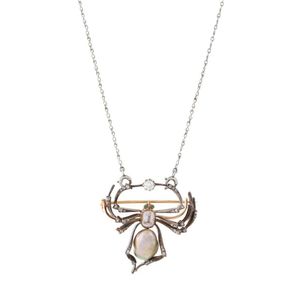Victorian Spider Brooch with Baroque Pearl and Gem-Set Thorax
Victorian spider brooch, modelled as a spider, the abdomen set with a Baroque pearl measuring approximately 0.47 in. x 0.39 in., with a gem-set thorax and circular emerald eyes, the legs accented at intervals with rose-cut diamonds, within its palp an old-cut diamond, mounted in 15ct gold and silver, length 1.50 in., width 1.34 in., gross weight approximately 11.0 grams, accompanied by a platinum chain (2).
You must be a subscriber, and be logged in to view price and dealer details.
Register Now to view actual auction price for this item.
- Victorian Period - The Victorian period of furniture and decorative arts design covers the reign of Queen Victoria from 1837 to 1901. There was not one dominant style of furniture in the Victorian period. Designers used and modified many historical styles such as Gothic, Tudor, Elizabethan, English Rococo, Neoclassical and others, although use of some styles, such as English Rococo and Gothic tended to dominate the furniture manufacture of the period.
The Victorian period was preceded by the Regency and William IV periods, and followed by the Edwardian period, named for Edward VII (1841 – 1910) who was King of the United Kingdom and the British Dominions and Emperor of India for the brief period from 1901 until his death in 1910. - Emeralds - Emeralds have been used in jewellery making for thousands of years, and are prized for their deep green colour, which is caused by the presence of chromium and vanadium in the mineral beryl. Because of their rare colour, emeralds are often more valuable than diamonds of a similar size and quality. In jewellery making, emeralds are typically cut into round or oval shapes to maximize their color and clarity. They are often set in gold or platinum and used as the centrepiece of a piece of jewellery, such as a ring or necklace. They can also be used in combination with other gems, such as diamonds, to create intricate and beautiful designs.
- Rose Cut - A flat based cut for a preious stone, leaving the surface covered with triangular facets, usually 24 in total.
It was introduced in the 15th century and popular during the 16th and 17th centuries.
The rose cut was the most popular form of diamond cut until the discovery of the brilliant cut at the end of the 17th century, after which its use declined.
This item has been included into following indexes:
- brooches, diamond
- brooches, gold - gold with pearls 957
- brooches, silver - silver items 2,659
